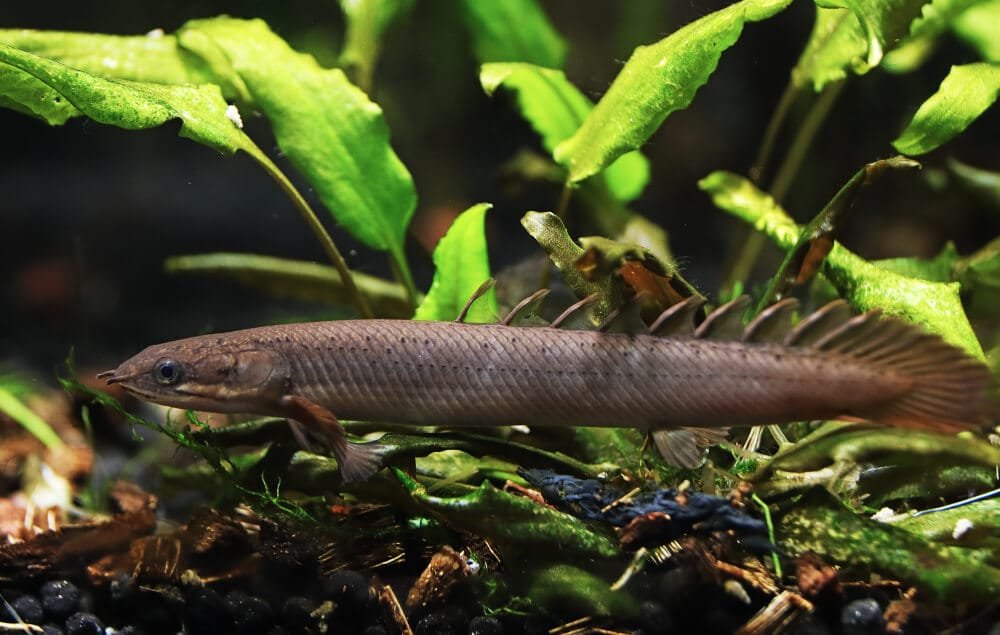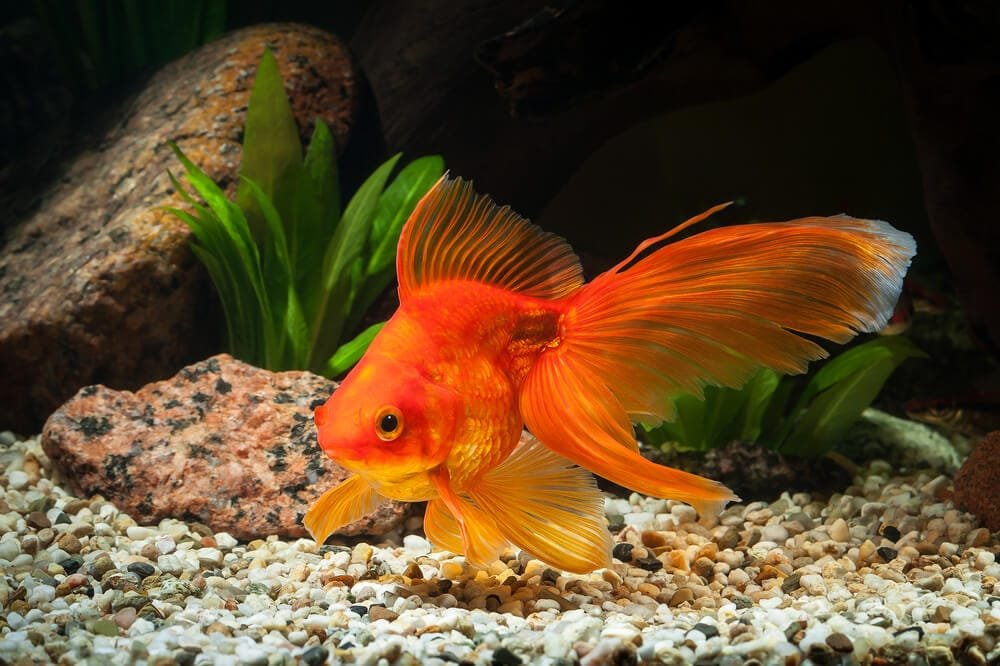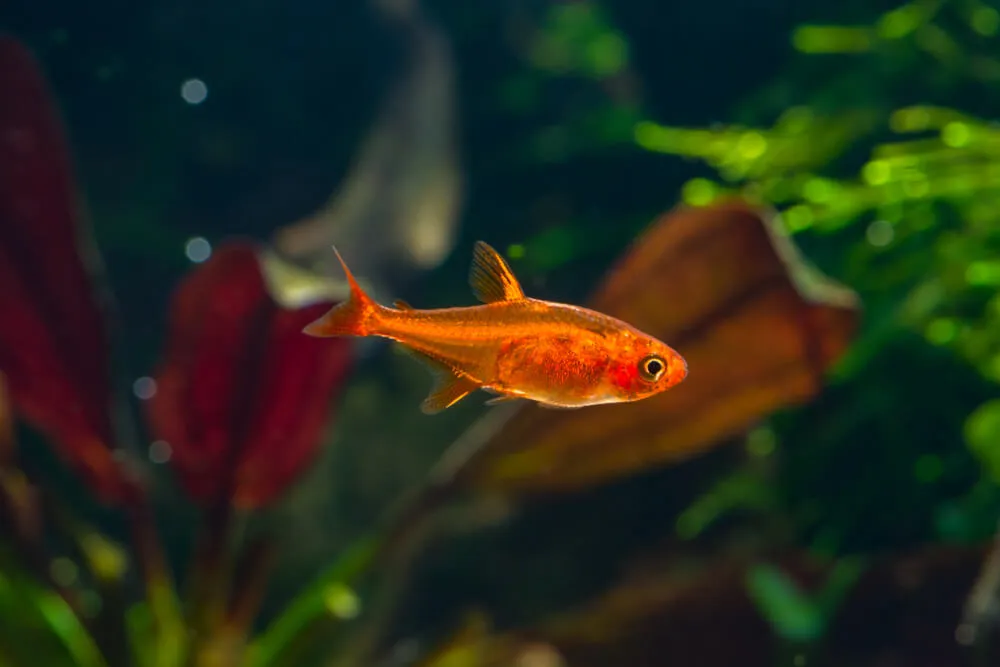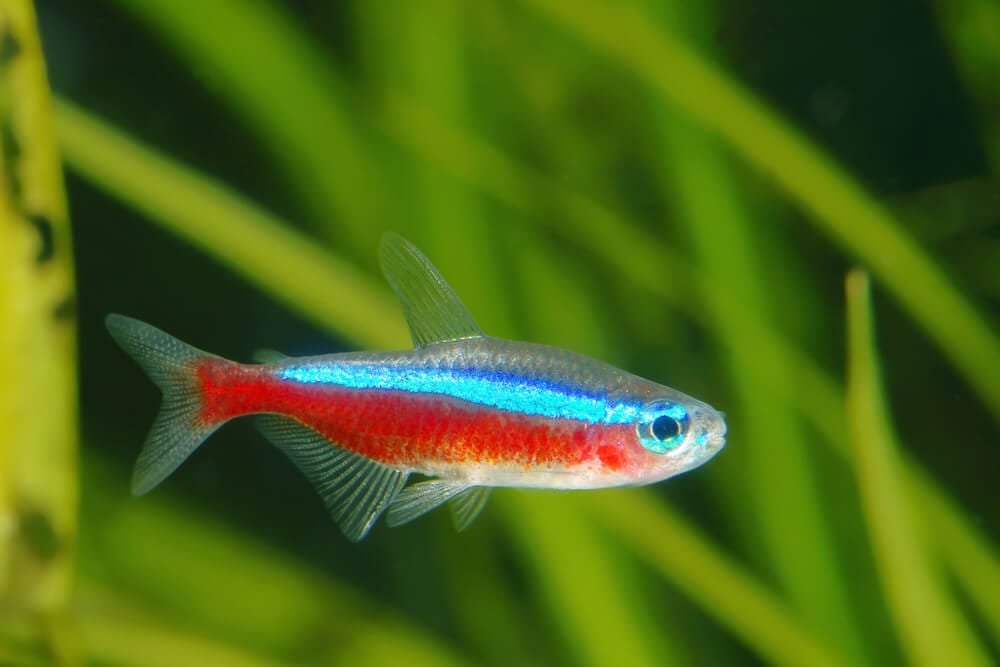Imagine a fish that has survived for 395 million years, even before dinosaurs. The dinosaur bichir is a primitive fish that has lived through time. It has adapted in ways that have helped it survive for so long.
Polypterus, known as the dinosaur bichir or relic fish, has a reptilian look. This makes it a favorite among aquarium fans and marine biologists. Its long body and ancient features give us a peek into Earth’s past.
The dinosaur bichir can grow up to 30 inches long and live for 20 years in the wild. It’s not just a fish; it’s a piece of history. Its ability to survive shows how nature can adapt and thrive.
If you love fish or are just curious, the dinosaur bichir is worth learning about. Its ancient looks and special ways of living fascinate scientists and fish lovers everywhere.
Introduction to Living Fossil Fish
The dinosaur bichir is a fascinating ancient fish. These creatures have lived for millions of years. They give scientists a peek into the past.
Bichirs date back about 60 million years. They are true living fossils. They have kept their amazing traits through time.
Origin and Evolution
Bichirs started as a unique group of fish in the Cretaceous period. Their journey through evolution is 395 million years long. They are among the oldest fish alive today.
The Polypteridae family has:
- 2 genera: Erpetoichthys and Polypterus
- 13 recognized species of nocturnal hunters
- Primarily found in African freshwater environments
Historical Significance
“Living fossils provide us a direct connection to prehistoric underwater ecosystems.” – Marine Biology Research Team
Scientists first studied these fish during Napoleon’s Egyptian expedition. French naturalist Geoffroy Saint-Hilaire documented them. He noted their unique traits.
Prehistoric Features
The bichir’s survival is thanks to amazing adaptations. These traits have stayed the same for millions of years. Their features include:
- Ganoid scales providing exceptional protection
- Modified lungs enabling survival in diverse water environments
- Primitive respiratory system allowing breathing both underwater and above water
| Characteristic | Details |
|---|---|
| Age of Species | 60+ Million Years |
| Total Species | 13 Recognized Types |
| Habitat | African Freshwater Systems |
| Average Length | 25-30 cm |
To understand these ancient creatures, we need to care for them properly. This includes keeping the water right and using a special filter. It helps them thrive in their tank.
Dinosaur Bichir: Overview and Species Types
The Polypterus genus is a group of ancient fish that fascinate aquarium lovers everywhere. Bichir fish are living fossils with unique features. They stand out among other aquarium pets.
The Polypterus genus has many species, each with its own traits and likes. Some well-known types are:
- Senegal Bichir (Polypterus senegalus senegalus)
- Ornate Bichir
- Gray Bichir
- Barred Bichir
- Saddled Bichir
These ancient fish are very adaptable in different aquarium settings. They need a diet rich in protein, like live and frozen foods. This diet helps them act like they do in the wild.
| Species | Average Length | Minimum Tank Size | Water Temperature |
|---|---|---|---|
| Senegal Bichir | 10-13 inches | 40-55 gallons | 77-82°F |
| Ornate Bichir | 20-26 inches | 90 gallons | 77-82°F |
Choosing tank mates for bichirs needs careful thought. Their territorial nature is important. The right substrate and pH levels, between 6.5-8.2, are key. They also need enough oxygen.
*”Bichirs are living windows into prehistoric aquatic life, showing us the power of survival.”*
With about 13 recognized species, bichirs continue to amaze scientists and hobbyists. They are a true marvel of nature and survival.
Physical Characteristics and Anatomy
The Dinosaur Bichir is a true marvel of evolution. It shows unique features that have lasted for millions of years. These ancient fish have a body that is unlike any other in the water.
Body Structure and Size
Dinosaur Bichirs have a long, eel-like body. They can grow up to 15 to 30 inches long. Their body shape is quite distinctive:
- Elongated, serpentine body shape
- Paddle-like fleshy pectoral fins
- Thick, bone-like scales providing natural armor

Unique Respiratory System
What makes these fish special is their lungs. They can breathe air, just like humans do. This lets them live in places with little oxygen, where other fish can’t.
Scale Pattern and Coloration
The Dinosaur Bichir’s scales are amazing. They are layered and shaped like rhomboids. These scales protect them, keeping them safe for millions of years.
| Characteristic | Details |
|---|---|
| Scale Type | Ganoid, multilayered, rhomboid-shaped |
| Color Variations | Mottled brown, green, and gray patterns |
| Body Armor Function | Protection and camouflage |
“Nature’s design in the Dinosaur Bichir represents millions of years of evolutionary refinement.” – Ichthyology Research Journal
Natural Habitat and Distribution
The Dinosaur Bichir is a prehistoric fish that lives in African waters. It has survived for about 60 million years. It has special traits that help it live in different water places.
Bichirs live in many African rivers, like the Nile. They are found in countries like Nigeria, Senegal, Kenya, Tanzania, and the Congo River Basin. They can live in many water types, such as:
- Swamp conditions
- River margins
- Floodplains
- Lake ecosystems
They have lungs that help them breathe in low-oxygen water. Bichirs are usually 30-60 centimeters long. Some can grow up to 97 centimeters.
The evolution of bichirs represents a remarkable testament to nature’s resilience and adaptive capabilities.
These fish can live up to 20 years. They become sexually mature at about six years old. Their wide range in Africa shows their success in evolution.
| Habitat Type | Characteristic |
|---|---|
| Rivers | Primary habitat with flowing water |
| Swamps | Low-oxygen environments |
| Floodplains | Seasonal water variations |
These amazing fish keep scientists interested with their ability to survive in tough water. They show millions of years of evolution.
Tank Setup and Housing Requirements
Setting up a home for dinosaur bichirs needs careful planning. These ancient bottom dwellers have special needs to stay healthy and happy in their tank.
Tank Size Considerations
Dinosaur bichirs need a lot of room because of their size and how they swim. You’ll need to invest in a big tank:
- Minimum tank size: 55 gallons
- Recommended tank length: 36 inches
- Tank width: At least 12 inches
Substrate and Decoration Essentials
The right substrate is key to creating their natural environment. Sand is absolutely critical for these fish. It protects their belly and lets them dig naturally.
Optimal Water Parameters
| Parameter | Recommended Range |
|---|---|
| pH Level | 6.0 – 8.0 |
| Temperature | 75-82°F |
| Water Hardness | 5-15 dGH |
“Provide a tank that respects their prehistoric nature and complex respiratory system.”
Design the tank with lots of hiding spots using driftwood, rocks, and plants. Their dorsal finlets and pectoral fins need room to swim and hunt. Make sure the tank has a secure lid, as these fish like to explore.
Feeding Habits and Diet
Dinosaur bichirs are fascinating predatory fish with unique dietary needs. In the wild, they eat small fish, insect larvae, and invertebrates. Knowing their nutritional needs is key for keeping optimal water quality and their health in captivity.
These prehistoric fish have specific feeding habits. They are mainly carnivorous, needing a diet rich in protein. Experts say about 80% of an adult bichir’s diet should be high-quality pellet food.
Nutritional Requirements
| Nutrient | Percentage |
|---|---|
| Protein | 45% or more |
| Fat | 3-6% |
| Fiber | 2-4% |
Feeding frequency depends on the bichir’s age and size. Young bichirs under 7 inches need small feedings all day. Feed them until a slight bulge appears in their bellies. Adult bichirs (7 inches and above) should eat twice a day, with a fasting day once a week.
- Initial feeding guideline: 2 pellets per inch of fish
- Avoid foods high in Thiaminase, such as goldfish
- Incorporate a variety of food types for balanced nutrition
“Variety is key in maintaining the health of these prehistoric fish.”
Good food options include live and frozen foods like bloodworms, brine shrimp, and small fish. Make sure prey items are under 3 inches long. Feedings should last 2-3 minutes, giving enough nutrition without overfeeding.
Social Behavior and Tank Mates
Dinosaur Bichirs are unique in their social behavior and tank mates. They have a complex nature that needs careful planning for a good aquarium. Knowing their territorial side is key for a peaceful tank.
Territorial Behavior and Interaction
Bichirs are semi-aggressive, showing their wild side. Watching their social interactions is vital to avoid fights. Signs of stress include being aggressive, moving less, and eating differently.
Compatible Species Selection
Choosing the right tank mates is important. Look for fish that are similar in size and nature. Good friends for bichirs include:
- Oscar Fish (55-gallon tank)
- Tinfoil Barbs (75-gallon tank)
- Knife Fish (100-gallon tank)
- Bala Sharks (125-gallon tank)
Aggression Management Strategies
To manage bichir aggression, design your tank well and control the number of fish. Follow these steps:
- Give them many places to hide
- Make sure the tank is big enough (at least 125 gallons)
- Choose the right gender ratio for breeding pairs
- Follow strict quarantine rules
*To live well together, understand the bichir’s ancient survival ways and create a tank that feels like their natural home.*
Keeping an eye on their health is also important. Watch their growth, how they fight off diseases, and their gender changes. This will help keep your tank full of life with these ancient creatures.
Health and Maintenance
Keeping dinosaur bichirs healthy is key. They have a special body and defenses. With the right care, they can live up to 15-18 years.
Bichirs have a strong skeleton. But, they face health risks. Keeping their environment clean and changing water often helps prevent sickness.
Key Health Maintenance Strategies
- Perform weekly water changes of 20-25%
- Monitor water parameters carefully
- Maintain temperature between 74°F-82°F
- Check pH levels between 6.2-7.8
Common Health Concerns
| Disease | Symptoms | Prevention |
|---|---|---|
| Ich | White spots on body | Maintain clean water, stable temperature |
| Bacterial Infections | Lethargy, color changes | Quarantine new fish, avoid overcrowding |
“Preventative care is always better than treating an established disease” – Aquarium Experts
Bichirs are active at night and need a special diet. They eat protein-rich foods like bloodworms and shrimp. This helps them stay healthy and grow.
Experts say watching them closely is important. If they get sick, act fast. With good care, these ancient fish can live long, happy lives in your tank.
Conclusion
Dinosaur bichirs offer a unique aquarium experience that needs dedication and knowledge. Keeping their environment right is key. This includes tank cycling, managing beneficial bacteria, and ensuring enough space for swimming.
Their prehistoric traits make them more than fish. They are a glimpse into the past. Understanding their needs is essential for their care.
Knowing their temperature needs and feeding habits is important. They can live up to 20 years with the right care. This makes them a big commitment for aquarium lovers.
Seasonal changes and breeding times are critical. Their courtship and specific needs must be met. This ensures their well-being.
Keeping dinosaur bichirs is a big responsibility. It’s not just about the aquarium. It’s about honoring their ancient lineage.
With patience, research, and care, you can give them a great home. This honors their amazing biological heritage.
FAQ
What exactly is a dinosaur bichir?
The dinosaur bichir, or Polypterus, is a living fossil fish from Africa. It’s called a prehistoric fish because it’s been around for 395 million years. It has ancient features like ganoid scales and can breathe air, making it very special.
How long do dinosaur bichirs typically live?
In a home aquarium, dinosaur bichirs can live up to 15-18 years. They need the right water, food, and a good home to live a long life.
Are dinosaur bichirs difficult to keep in an aquarium?
Dinosaur bichirs are not for beginners. But, they can be kept by those with some experience. They need a big tank, stable water, and careful tank mates because they can be a bit aggressive.
What do dinosaur bichirs eat?
These fish eat a lot of protein, like their wild diet. In a tank, they like live and frozen foods like bloodworms and shrimp. A varied diet is key for their health.
Can dinosaur bichirs breathe out of water?
Yes, they can breathe air using special lungs. This helps them survive in low-oxygen water and even lets them briefly leave the water. It’s a cool trait from their ancient past.
How big do dinosaur bichirs grow?
Dinosaur bichirs can grow 12-30 inches long. The size depends on the species. Some stay small, while others can get quite big in a good aquarium.
Are they good for community tanks?
Dinosaur bichirs can be in community tanks, but with care. They can be a bit aggressive and territorial. Choose tank mates that are big enough and not seen as prey.
What makes dinosaur bichirs unique in the fish world?
They are unique because they are living fossils. With features like primitive lungs and scales, they offer insights into fish evolution. They’ve been around almost 400 million years.
What water conditions do they prefer?
They like tropical freshwater with temperatures between 75-82°F. The pH should be 6.5-7.5, and the water should be moderately hard. They need good filtration and like environments that remind them of African rivers.
How often should I feed my dinosaur bichir?
Adult dinosaur bichirs need to be fed 2-3 times a week. Younger ones might need more food. Always watch their condition and adjust feeding to avoid health problems.






